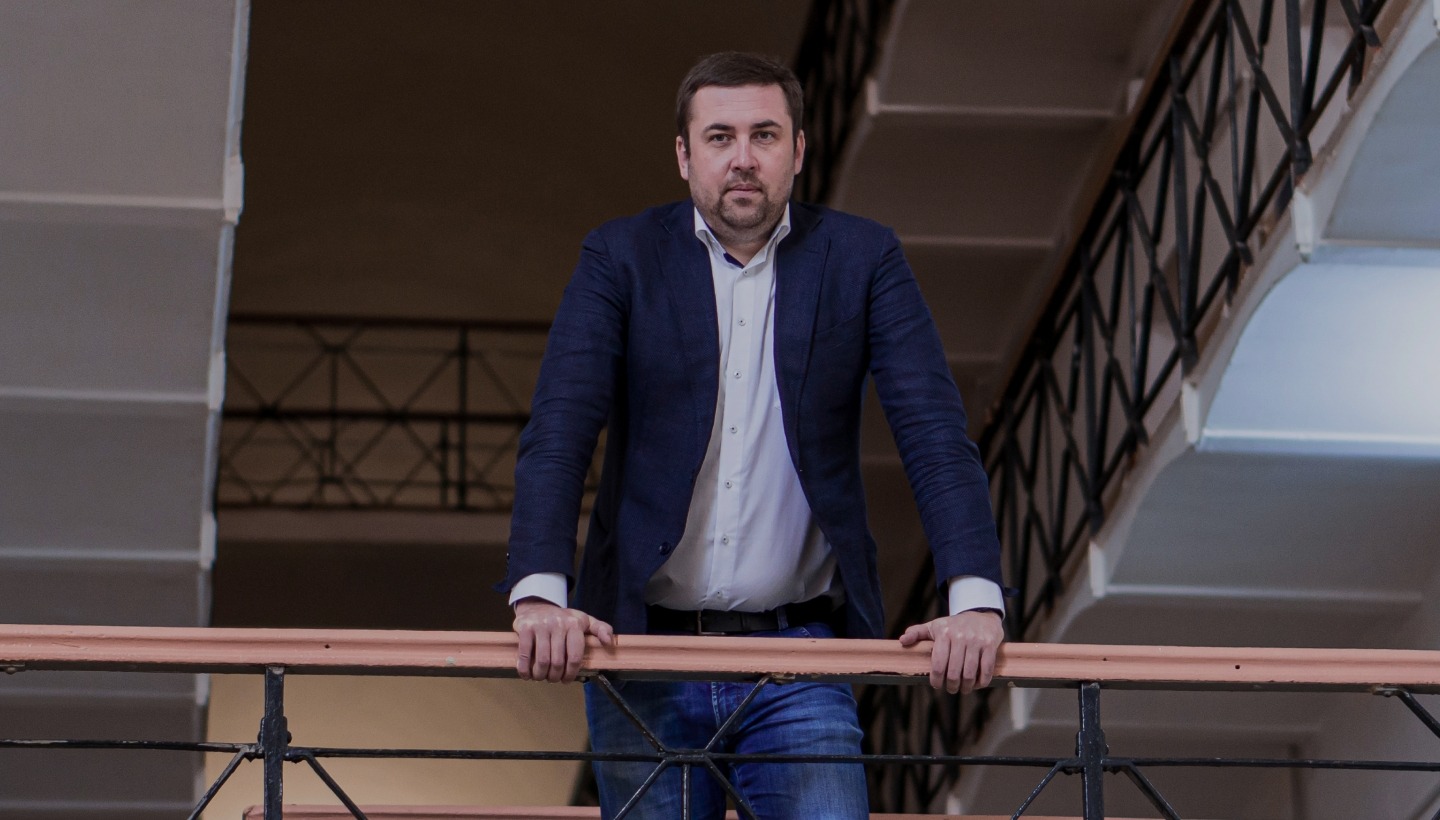
Samara State Medical University (SamSMU) received the status of a leading research center for digital economy in the field of «Virtual and Augmented Reality Technologies» along with a state grant. Director of the SamSMU Institute for Innovative Development Sergey Chaplygin and his deputy Vitaly Kuzmin talk about the new opportunities of the University, virtual reality training for doctors, its very own Technopark and non-medical inventions of the institute.
SamSMU and the status of LRC
Today, SamSMU is a technological valley, where people are conducting studies, treatments and practical science. We apply the best practices of classical Russian medical science and international practices. In particular, the Stanford University management model is applied, as well as its approaches in creating an innovative ecosystem. Small innovative enterprises were set up around our University, there is a startup center for screening and accelerating new ideas, besides that there is a system in place that deals with attracting venture financing and practical implementation in the largest enterprises of the Russian Federation and the CIS states.
SamSMU is developing new progressive methods and approaches of advanced medicine, which are embodied in popular software and hardware-software systems. Today Russian medical science is in dire need of innovative and ground-breaking solutions and approaches. Despite the fact that historically our clinical basis and the level of medical personnel training are good, we’re looking to advance technological base to catch up on the gap of 90s.
We’ve been working on virtual and augmented reality since 2013. We started to form the core of developers, the culture of production and cultivate a new generation of specialists from day one. In 2015 we conducted the first-ever surgery using augmented reality glasses. We managed to beat Microsoft, a leader in AR technology at the time, which conducted the same operation only a few years later.
SamSMU had everything at its disposal to participate and win the LRC competition. The new status and the state grant will allow us to expand markets to sell our technologies and products, as well as diversify our geography.
Info
Background information about the LRC competition
In 2019 RVC announced a competition among leading research centers (LRC) and leading companies in the development of products, services and platform solutions based on end-to-end digital technologies. The winners of the LRC competition are seven educational and research organizations that will go on to develop digital technologies with commercial companies. The amount of approved grants for the implementation of each LRC programme activity ranges from 224 million rubles to 300 million rubles for a period of up to three years. Taking into account extrabudgetary funds the total amount of costs for projects is approximately 3 billion rubles.


The Institute began to develop and implement cutting edge technologies for treating diseases (illnesses) and training doctors.
The projects that started it all
In 2014, having reorganized the Department of Innovative Technologies, SamSMU created an autonomous structure called the Institute for Innovative Development. Its primary focus is on IT medicine. The Institute began to develop and implement cutting edge technologies for treating diseases (illnesses) and training doctors.
The first projects dealt with training medical personnel. We began to make robotic simulators for our students so they could study special manipulations. However, the main drawback of these simulators was that they were expensive and not intended for mass use. In addition, they did not provide feedback and create the necessary conditions for students to immerse into the educational process.
We started to think about ways of optimizing the simulators. We did some research, looked at foreign practices and realized that it was necessary to go digital. So we refocused our team to work with VR&AR technology, developing the first prototypes of training simulators for performing a cricothyrotomy (where an incision made to establish a patent airway) and a larger training simulator for conducting open surgery. We were able to achieve a high degree of realism. We are especially proud of the multi-user mode, where surgeons and surgical assistants from around the world can conduct joint operations on the open surgery simulator.
Soon afterwards products for patient rehabilitation were added to our educational programmes.
Details
ReviVR
VR system for passive rehabilitation with tactile feedback. This is extensively used after patients experience strokes and brain injuries. The high efficiency of the rehabilitation course is maintained at the acute, early and late phases. About 3,000 patients in Russia and Kazakhstan underwent rehabilitation with ReviVR and managed to improve their physical activity.
VR complex ReviMotion
Video game rehabilitation system for children and adults. It is intended for rehabilitation of patients with movement impairments caused by lesions of the upper motor neuron, extrapyramidal disorders, cerebellar, frontal lobe and vestibular ataxia. ReviMotion is actively implemented in rehabilitation centers across Russia. In 2019 more than 4,000 patients underwent rehabilitation courses.
Virtual surgical clinic
In 2015 we developed an augmented reality surgical navigation system. Eventually we created a product called Autoplan. This is the first surgical navigation system developed and registered in Russia, its unique design features a stereo camera. The complex is already used in the country’s leading clinics, such as the Burdenko National Medical Research Center for Neurosurgery and the Sklifosovsky Clinical and Research Institute of Emergency Medicine in Moscow.
We are continuing to enhance and develop the Autoplan surgical navigation system and we are coming up with related products such as a radiologist workstation.
As part of the LRC programme, we will develop an integration module with operational microscopes for Autoplan. This is necessary to improve the quality of neurosurgery. How will it work? The doctor runs a computed tomography scan, he constructs a virtual 3D model of the patient’s brain and does preoperative planning. In the operating room, the neurosurgeon «lays» the three-dimensional model over the patient’s brain, tracking the movements of the instruments and the boundaries of the tumor on the microscope screen. The new module will give the neurosurgeon the opportunity to quickly, efficiently and safely prepare for a complex surgery and reduce possible risks for the patient.

We are continuing to enhance and develop the Autoplan surgical navigation system and we are coming up with related products such as a radiologist workstation.
As part of the LRC programme, we will develop an integration module with operational microscopes for Autoplan. This is necessary to improve the quality of neurosurgery. How will it work? The doctor runs a computed tomography scan, he constructs a virtual 3D model of the patient’s brain and does preoperative planning. In the operating room, the neurosurgeon «lays» the three-dimensional model over the patient’s brain, tracking the movements of the instruments and the boundaries of the tumor on the microscope screen. The new module will give the neurosurgeon the opportunity to quickly, efficiently and safely prepare for a complex surgery and reduce possible risks for the patient.
By the end of 2019 more than 900 successful operations were carried out in Russia with the use of the Autoplan system. The complex received positive assessments based on the test results in Université Jean Monnet (France) and Heinrich Heine (Germany).

Sergey Chaplygin
Director of the SamSMU Institute for Innovative Development

Vitaly Kuzmin
Deputy Director of the SamSMU Institute for Innovative
Development
Links between science and business communities
Within each product team, there is a product owner and a business analyst. These people contact customers and offer them the best solutions. We use the best project management practices by applying flexible approaches to (product) development. SamSMU is a well-known brand in the medical market and we receive a large number of orders from our customers. In other industries such brands would face fierce competition.
We are vigorously gaining new niches and offering new products based on VR&AR. One of such in-demand designs for large enterprises is a software-hardware system that identifies deviant staff behavior. Other examples would be a software-hardware system that imitates different natural disasters and a software-hardware system that trains staff to operate complex technological equipment.
70%
of commercial customers of the SamSMU Institute for Innovative Development are medical companies
Currently, 70% of commercial customers of the SamSMU Institute for Innovative Development are medical companies. 30% are within the industry and the education sector. It is estimated that in 2020–2021 the number of non-medical orders in the institute’s portfolio will increase to 50% — 60%.
Center for Advanced Studies (CAS)
In 2014 we participated in the competition organized by the Russian Ministry of of Digital Development, Communications and Mass Media where the goal was to establish centers for advanced studies. SamSMU was the only medical university to win this competition. All of our IT development is concentrated in this center. CAS has become the foundation of LRC and our technological base. Now the center is focused on artificial intelligence technology, analysis and processing of big data. CAS is at the final stages of completing the most important project, which is a software platform for collecting and monitoring citizens medical data and their overall health. The product brings together patients’ surveys, information about health from mobile devices and domestic appliances, and the results of in vitro and radiological studies. Currently, some platform modules are used in practical health care. Currently, some platform modules are used in practical health care.
Technopark
Ten years ago we tried to develop prototypes in factories and this turned out to be costly and time- consuming. Large manufacturing plants are simply not interested in working with just one sample. Having our own production was a reasonable solution and that is how the Technopark was launched in 2013. This facility allows us to put our theories into practice, conduct experimental and industrial research and develop turnkey solutions for a variety of problems, significantly reducing development time and cost of final products.
SamSMU is the only medical university in Russia that created a full-fledged small-scale production. It provides a wide range of services and operates on the full cycle principle: from generating ideas together with the customer to creating of a small-scale prototype. Today the Technopark manufactures up to 200 products per year. The Technopark has its own design, manufacturing and electronic components departments. Part of LRC programme is implemented at the Technopark.
Implementing end-to-end virtual and augmented reality technologies at the SamSMU in 2019
104million rubles
were raised from sales of software-hardware systems for surgical navigation and patient rehabilitation
41million rubles
Is the cost of developed and implemented software products
120million rubles
is the revenue approximately made by SamSMU small innovative enterprises
160million rubles
were attracted as extrabudgetary funds for research and development projects of the University


